

The Skuldelev Longship

An interesting example of engraved pictorial stone (Gotland Island, Sweden), providing a starboard broadside view of a longship, with excellent details on the scandinavian rigging. This ship is equipped with bowlines, and net briddles.
This page is kindly dedicated to my friends in Palma de Mallorca, Catalina and Jaime, with whom I share the love for ships and salt water, and who specially encouraged me to build the model..
The Ship:

A barrage believed to be built of wood and stone at Peberrenden, a channel of the Roskilde fjord at Skuldelev, west of Copenhagen, to protect the city in ancient times from raiders, was indeed built scuttling 5 ships.
After careful inspection by the local museum to check the old legend (1957-59), it was discovered, the barrage had been in fact built scuttling 5 ships. The wrecks were carefully excavated using a kofferdam (watertight enclosure), and the remains are now exhibited in the Vikingskibhallen at Roskilde.
There are 2 warships, 2 merchants and 1 fishing boat. I selected the smaller warship (#5), the hull of which was practically recovered by 50%, in order to base my model.
The Model:
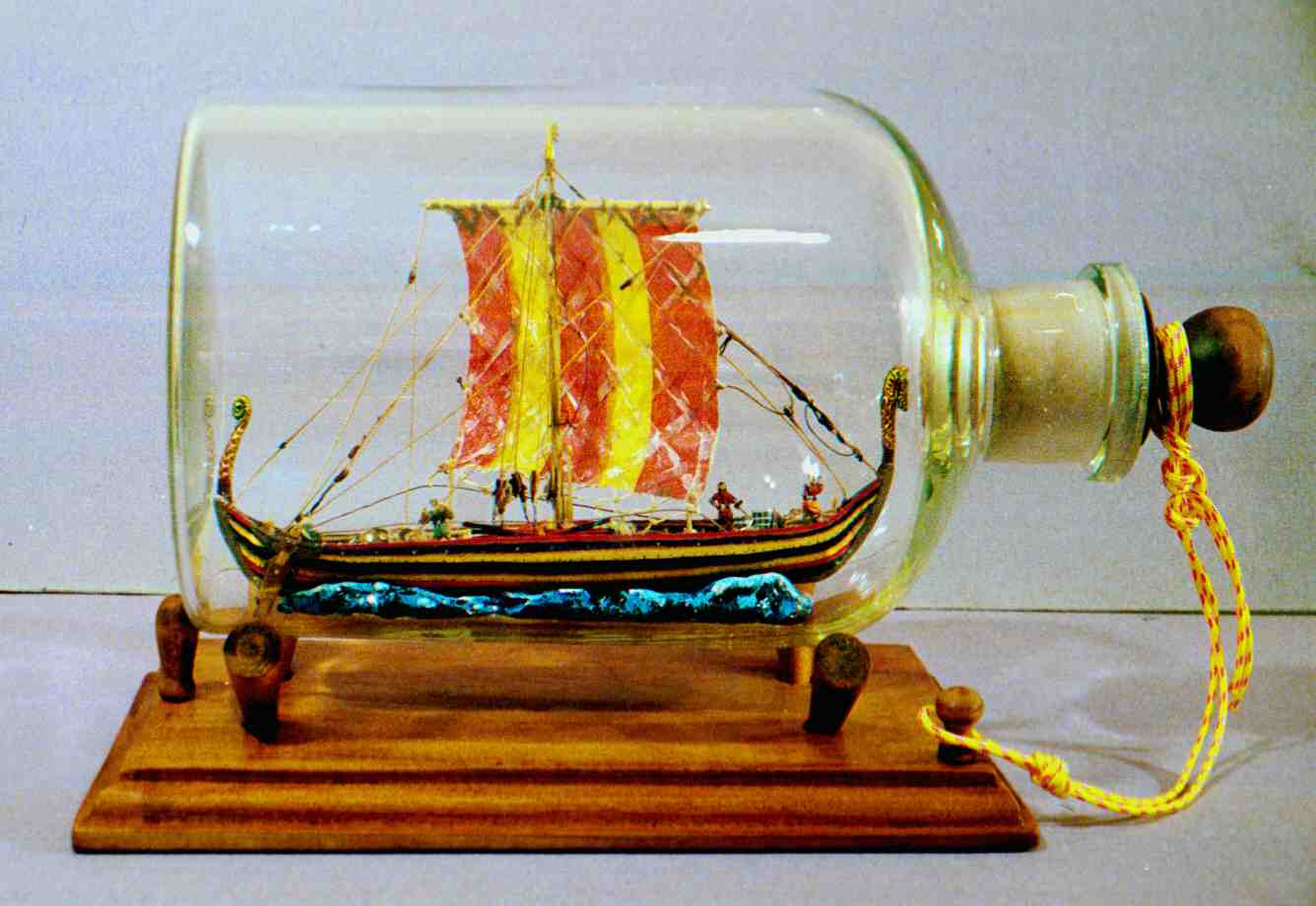
The Plans and constructional details:
As I have said, the plans base on the Skuldelev 5 wreck, with the hull made to scale (1:100) as per the original ship.

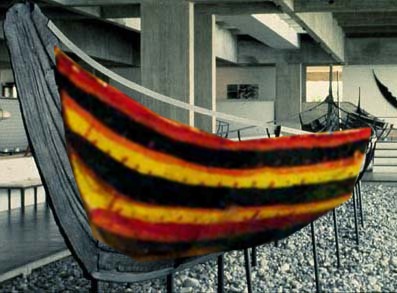
Rigging is an educated guess from many sources, block and tackle taken from the Gokstad findings, stays, bowlines and net briddles from pictorial stones. I also based on the present sailing scandinavian reconstructions, adding a little of my investigation to end up in the rigging of the model.
The hull strakes painting was taken from the Bayeux Tapestry. Skuldelev is practically contemporary (Dendrochronology dates the vessel to 1030-1050). We also read many early references in the Sagas, of painted ships. For instance, the shields found on the Gokstad ship had traces of paint, alternatively yellow and black.
I therefore selected the ship pictured below, for the hull's main scheme. I only decided to paint red the strake above the oars (see Bayeux's ship bow, there is a red part, though it could be the bow/stem structure's inner reinforcement) and the 7th strake (in the picture supposedly below the waterline) black.One important comment on the waterline. The Skuldelev ship probable LWL would hit the 4th strake amidships, but I prefered to cheat this and show the ship a little higher, to expose more hull. Another interesting detail is the draught of this ship is deeper aft and shallower fore. I understand this simultaneously made steering and also disembarking or stranding the ships on shores easier.
Please note herebelow the hull of the model superimposed to the original Bayeux Tapestry ship:
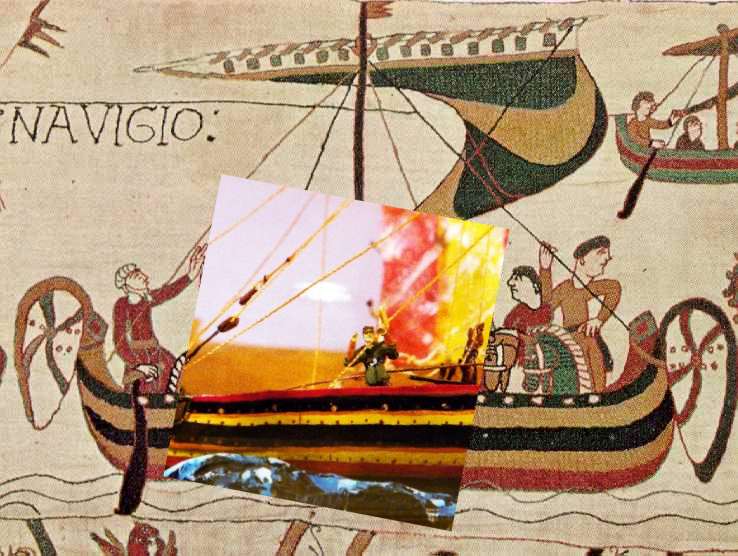
Sailing the ship
One of the main aspects of this model, rests on the fact it has been equipped as if it was to sail, and all the running rigging fittings do actually work. (OK, almost. f.i. no spare lenght of rope was left to adjust the braces)
In the following picture, we see all the blocks and tackle. They are 2 simple for the main yard braces, 4 double (2 for the main forestay, 2 for the yard hoist) and four odd shaped "virgins" foreruners to the deadeyes, which adhering to the latest interpretation, should be the shroud tightening rig.
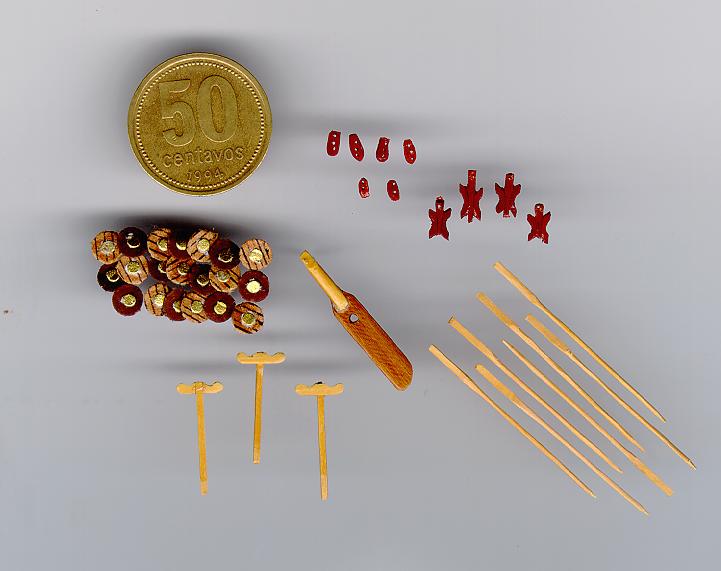
The picture also shows 20 shields alternating light and dark wood, which were stored ( I assume aft of the mast), when sailing, not hung from the railings. We also see the 3 "T" shaped yard support poles, some 7 oars (they are stored starboard of the mast step, the whole lot would have required 26) and the famous steering board. Not in the picture but on the ship, we can see the jury sail & spar, dtored port of the mast step.
Living on board:
The following picture shows the crew and living on board accessories. Please note the anchor (based on the anchor found within the Oseberg burial) is included here, because it didn't make it into the rigging picture.
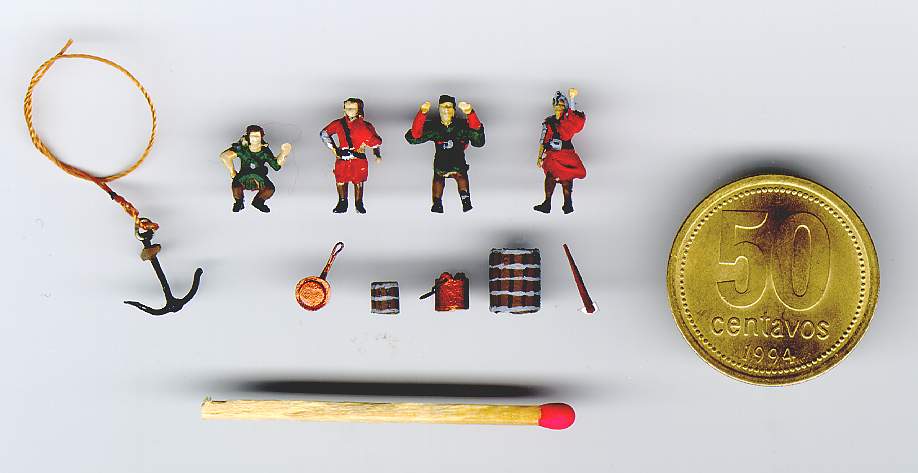
The utensils:
The 'live aboard' details, are mainly items found in the Oseberg burial. I have placed these items near the fore quarterdeck, were kitchen accessories would have most likely be stored. Nevertheless, the layout honours the Oseberg finding and the Oslo Museum display (pls compare photos below).
.
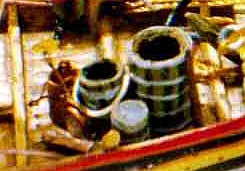
Crew:
I selected a top notch and gallant crew to sail this vessel boldly. From left to right, in the picture, far above:
The Helmsman, Leif Ericson:His strong and bold arm steered his vessel to Vinland, North America. This land had been previously seen by Biarne Herjulfson, who not dared to get to the shore. Leif decided to make the trip and land ("now we won't have it said of us, as it was of Biarne, that we did not go ashore") He went ashore 3 times, naming the places Helluland (a land of rocks, probably Newfoundland), Markland (a forest land, probably Nova Scotia) and Vinland (the land of grapes, now supposed near L'Anse aux Meadows) , due to their characteristic features
The standing swordman, Olav Trygvason:A famous king (968-1000). His most famous ship was the Long Serpent. He valiantly fought the battle of the Svold. (the foes were the kings Swein, Olaf and Eric the Jarl) He resisted as much as he could, on board his beloved ship. But in the end ("Too weak, too weak is the king's bow") he was defeated.
The man at the braces, at the starboard gunwale is Torberg Skavhogg. Reportedly the best viking stemshipwright ever. He deliberately hacked the gunwales of King Olav's Long Serpent, because he was away on home leave when the ship was being finished. He confessed to the king, and as punishment, was to repair the gunwales. He reshaped them, and the ship was finer than before, so the king thanked and pardoned him.
The helmeted norseman pointing to a far coast, Harald Hardrade Sigurdson. Sailed to conquer England in 1066, on the verge before Hastings. The last norwegian king to commit to traditional viking warfare. His brave army landed at the Orkneys and moved southwards along the coast to Scarborough. After subduing this town moved to the Humber and up this river to York, which he conquered too, after defeating the saxons at Fulford. He was later to fall at Stamford Bridge.

I prepared the following rough sketch to calculate all the accessories and to lay them out on deck, on the most probable way. I concluded the deck would have been crammed, even considering all the crew's chests were stored below the deck planking, and not thinking on an ocean crossing, but on a warfare trip (and still 22 men are not aboard!).

Herebelow a starboard tack view of the model showing all the kitchenware items displayed. Harald stands on the raised prow platform, while Olav holds his stance on the port gunwale beside the bowline fastening bitt, holding his sword.

Dragon's head:
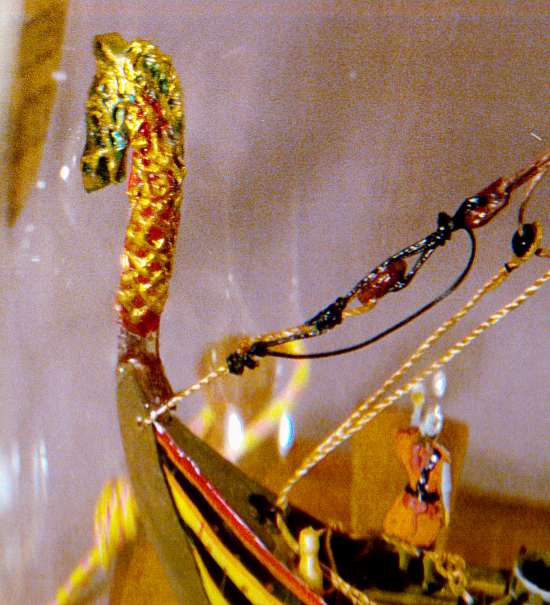
The dragon's gold-green mane
Shines o'er the deck; the neck
Bore burnt gold. Then
It glided from its moorings.
Tjodolv the Scald. The History of Harald Haldrade
Weather vane:
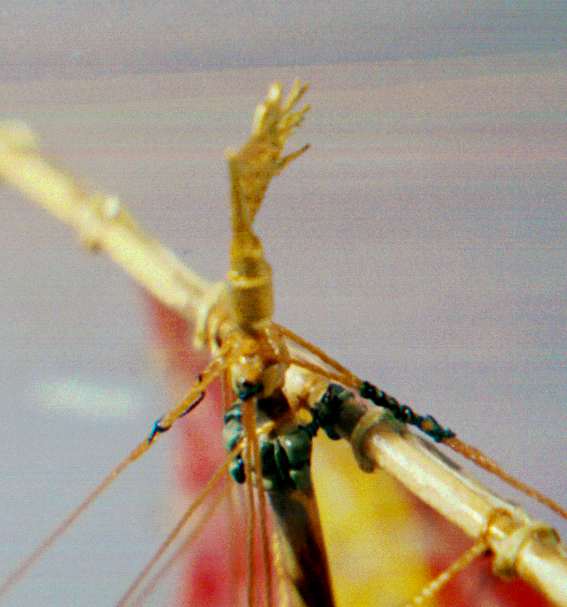
The tops of the masts
There gleamed like fire
Arnold Jarlascald. The History of Magnus the Good
Tjodolv the Scald. The History of Harald Haldrade
The Stern: Dragon's Tail and Rudder:
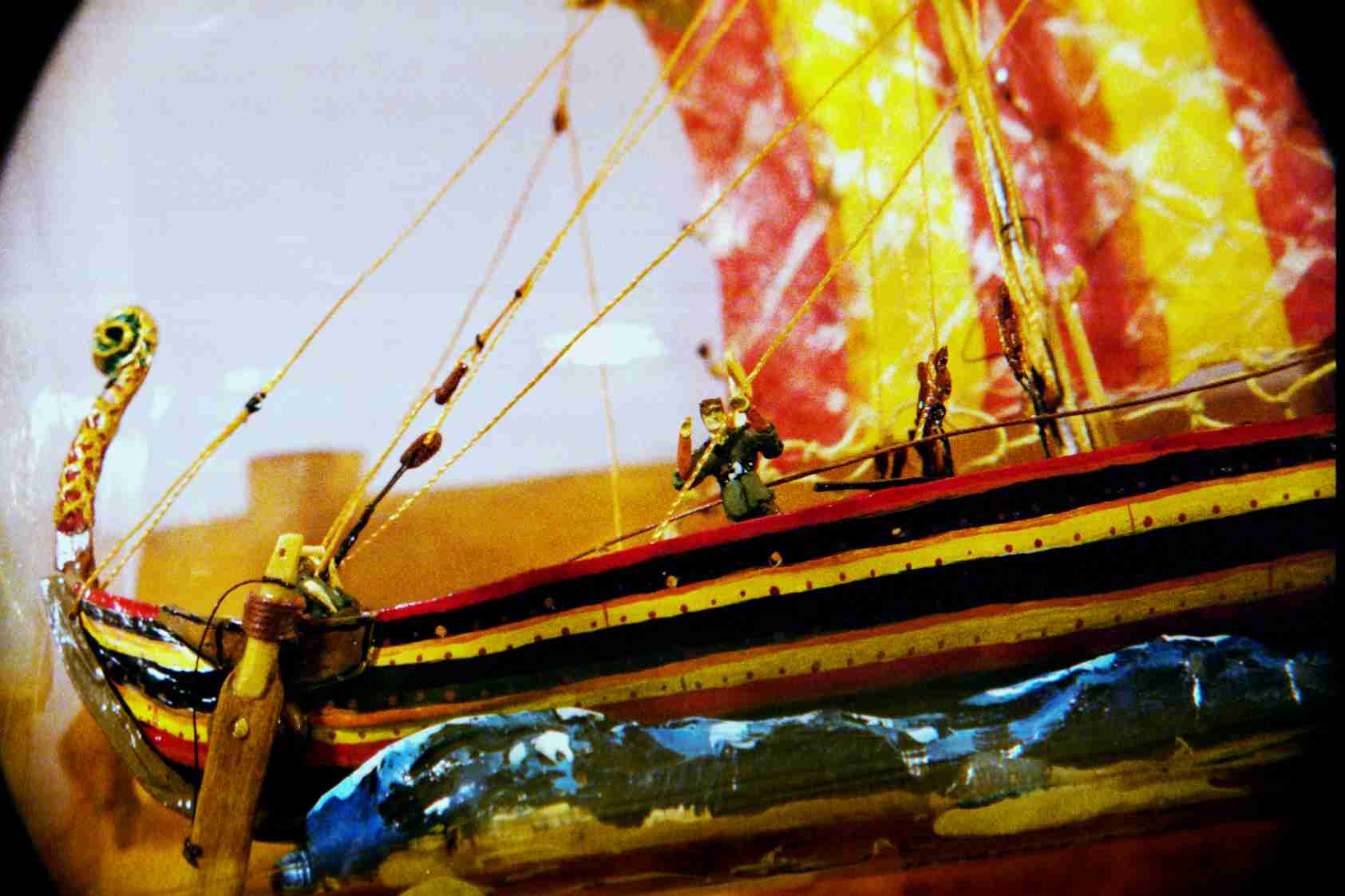
Offshore bound!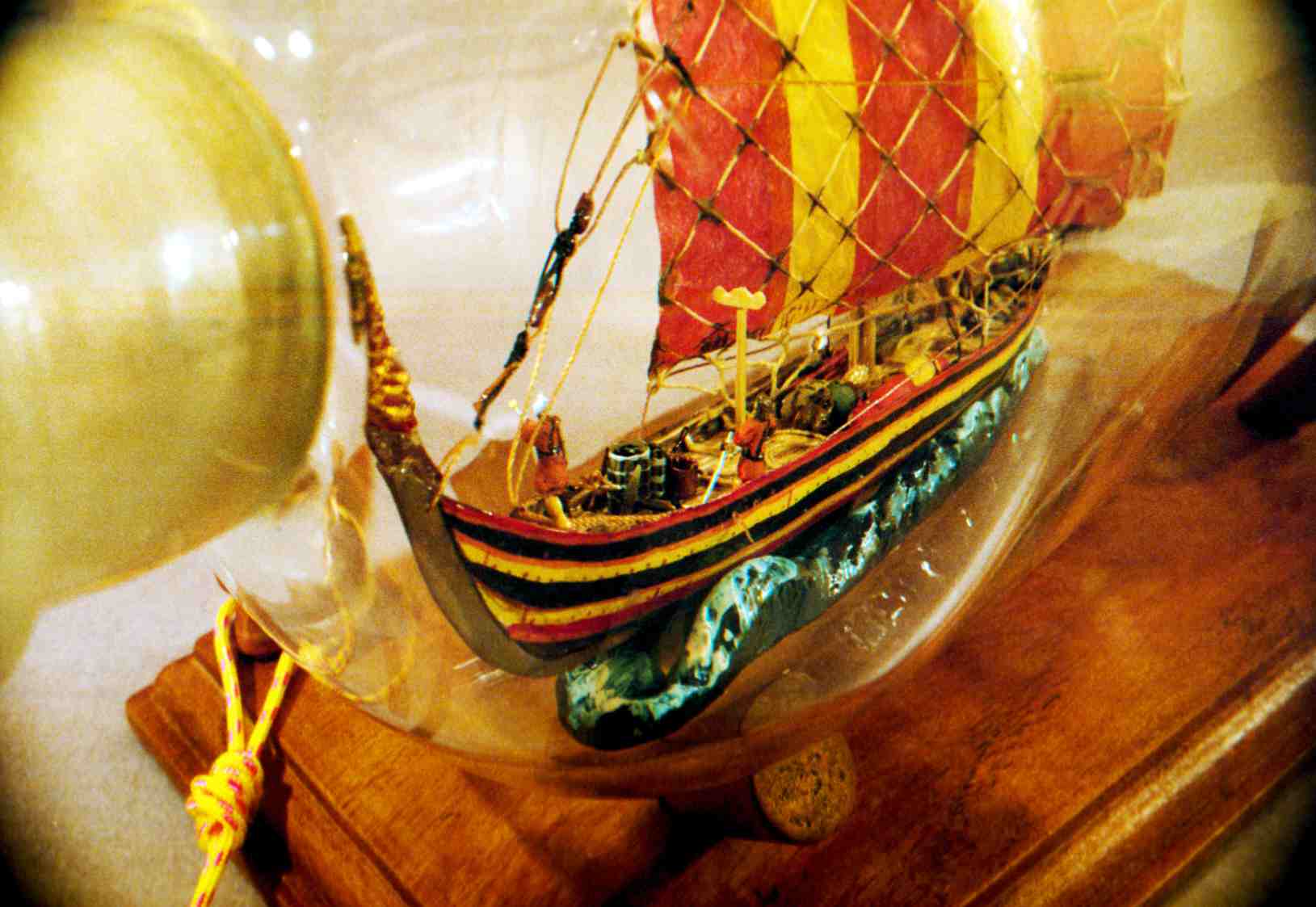
The keel glided to the south,
and the sail strained the ropes.
The high masted ship cut through the creeks,..
Tjodolv the Scald. The History of Magnus the Good
..from outside, the ugly sea-foam squirted
Against the quaterdeck; the rudder shook,
The wind bent the red-fir timbers
All bedecked with the red gold
Arnold Jarlascald. The History of Magnus the Good
Appendix:
Vikings and their Ships. Overview
The viking long ship (langskipet) excelled during mid IX century. Back then, the scandinavians had evolved from their oar driven coastal vessels Faering (small rowing boat) used to move within the fjords, to the sail propelled keeled versions, the many subtypes of which were the Karv (coastal vessel), Knarr or Knörr (cargo or merchant ship), Drakkar and Snekkar (also called Skeid(*), fighting vessels). With these, specially with the bigger oceanic type, the Skeid, they moved out to far places, in a "hoping islands" fashion, reaching Iceland, Greenland and ultimately the so called Vinland (Leif Eriksson's Saga) which we today consider was in fact North America.
(*) Skeid: According to Snorre's Heimskringla, the Skeids were built on specially fine lines, and were swifter than other vessels. Sometimes they didn't wear a dragon head. We consider them derivative of the Snekkars. Following this criterium, the Oseberg ship which indeed was a Snekkar judging from the serpent head which was found within the rests and allowed to be reconstructed, must have been a Skeid, thanks to its slender lines. Some naval specialists think it was very small, and therefore a Karv.
We have learnt to identify these ships as holding rows of shields hung from the gunwales, and terrifying dragon or sea monster heads as figureheads on the bows. But such ornaments had specific uses even determined by their local laws. In fact, the shields (which were hung using strings) were exposed only on certain ceremonial occasions, and would have surely been washed away by any mid size open water wave. As for the figureheads, they were never used on friendly areas: They were intended to intimidate enemies during raids or naval battles. Using them in home waters would have "scared away" friendly spirits.
The vikings did not know the compass or magnetic needle, but they sailed with astonishing (or at least practical) accuracy.They usually passed on the information on currents, landfalls etc. Also, they relied on a sort of graduated sundial by means of which they could determine the height of the sun and fix an approximate position. On certain special occasions, mostly when it was cloudy for a long time (as it normally appears to be in northern latitudes) they would exceptionally use a kind of special light polarizing crystal or sunstone. Light passing through the stone would turn from yellowish to blueish when perpendicular to the sun rays, thus allowing to set the angle, even when not directly receiving the rays.
But, they indeed attained high specialty in the construction of their perfectly suited ships, and in the sailing techniques. They could sail into the wind holding the windward edge of the big square sail by means of a special spar or long pole, a boom, they called Beitass. This spar rested on the low deck on a special foot plate or chock with two depressions to avoid slipping. It disappeared later, when the bowlines (although contemporary of the beitass) became dominant.
A word on the construction techniques, and rigging:
For the ocean-going, later types, they would lay the "T" shaped keel, add the massive stern and stem. The hull was then assembled from the clinker straked sides, later "U" shaped ribs and beams. The fixing of the strakes succeeded using small blocks and sinew ties. This provided a spectacular, much needed flexibility to the hull. A massive mast foot of peculiar shape with a slot and blocking wedge was used to hold the mast upright.
When the system of stays and shrouds was improved, the mast step became smaller, as it is evident in the Skuldelev 5 wreck.
As for the rigging, we have already mentioned that the beitass or bowlines were used. The great sail was strengthened by means of a crosswork of bridles, later hanging like net sheets, by means of which the sail's foot was held evenly. Although a great number of blocks was found within the Gokstad burial mound, the ropes had rotted away, so its function within the rigging is uncertain.
There were also three poles with crossbars, that were probably used to rest the sail spar, when this was not hoisted. This could be observed both in the Gokstad and in the Skuldelev finds.
The famous skandinavian rudder, the stjorbordi, was rigged up the right side. Made firm by a grommeted "rope" (pine root sinew) to an oak boss, the upper part was tied with ropes through two holes in the gunwale. A tiller, perpendicular to the rudder shaft, permitted steering. A ring on the blade allowed for a rope to be used to hoist the rudder, when the grommeted rope was slackened, thus allowing to sail/row the craft even on shallow waters.
Bibliography:
Heimskringla or The Lives of Norse Kings, Snorre Sturlason, Dover Publication reprinting of W.Heffer & Sons Cambridge; Viking Ships Findings, Universitetets Oldsaksamling Oslo,The Vikings, Lords of the Seas, Yves Cohat,The Ship - Björn Landström. Runes taken from First Futhark, The Book of Old Ships, Henry B.Culver, Historische Schiffsmodelle. W. zu Mondfeld, Eyewitness: Boats, Dorling Kindersley. The Visual Dictionary of Ships and Sailing,Dorling Kindersley. Las Artes de la Mar. Enciclop. Gráfica Ilust.,Tre Tryckare, National Geographic Magazine.(Atlas and various issues, esp. April 1966).
Note: The background art of this page is taken from the Bayeux Tapestry (ca. 1077) It depicts, in this part, the Channel crossing by William's fleet in September 1066, to invade England. The Tapestry is exhibited at the Museé de la Tapisserie, Bayeux, France)
(c) 2002-2020 Eduardo Raffaelli. Buenos Aires . Argentina